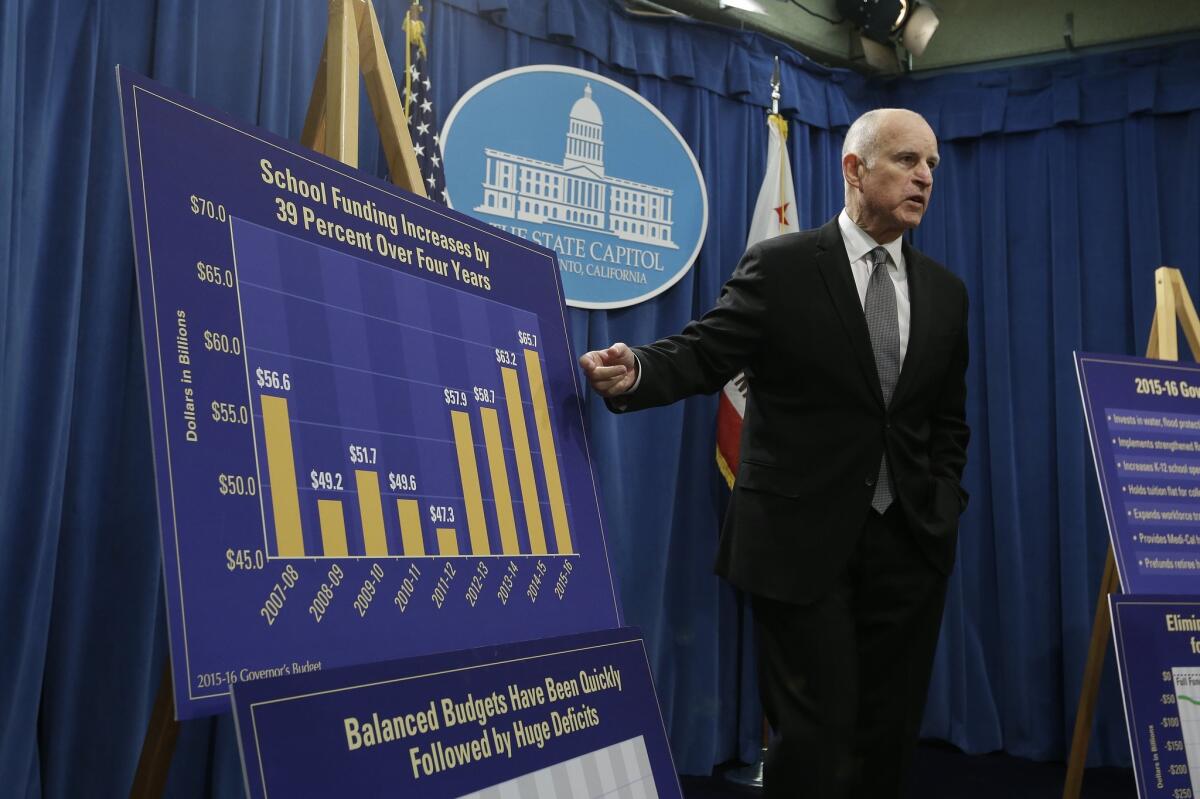Editorial: Keeping better tabs on California’s education funding

Gov. Jerry Brown gestures to a chart showing the increase in school funding in the past four years at a news conference in Sacramento on Jan. 9.
One of Gov. Jerry Brown’s greatest and most dramatic accomplishments has been his reform of the way California allocates money to public schools. He used the recession to hit the reset button, replacing an arcane and blatantly unfair formula with a streamlined and equitable distribution: a certain amount of funding per student, and significantly extra for those who are poor, in foster care or not fluent in English — in other words, students who need extra help.
------------
FOR THE RECORD:
School funding: A June 18 editorial about public school funding for disadvantaged students said the Fresno Unified School District sought permission to use the money for across-the-board teacher raises. It was the Fresno County Office of Education that asked whether the money could be used in that way.
------------
But this fairer approach will work only if school districts are committed to spending the money for the benefit of the disadvantaged students for whom it was intended, and early signs are that at least some school districts are defining that benefit broadly — perhaps too broadly.
The Fresno Unified School District, for instance, is seeking permission to use the added funding for teacher raises. Now a study from UC Berkeley finds that Los Angeles Unified has spent a significant portion of the extra money on library aides and assistant principals for schools districtwide, not just those with the most students in need.
These developments are troubling to some of the people who initially cheered the Local Control Funding Formula, and they’re right. Of course some flexibility is needed, but there is enough cause for concern that the state should be thinking about tighter, though still-sensible, controls.
In a district such as Fresno Unified, where 86% of the students qualify for extra funding, it might make sense to spend it on teacher salaries, at least at first. Teachers in many California schools have gone without raises for years; they have lost income to furloughs, while many have continued to pay out of their own pockets for necessary classroom items. When almost all the district’s students have exceptional needs, a stable and fairly paid teaching staff might be the best improvement Fresno could make for them, even though it also, incidentally, helps a small group of less needy students too. This kind of spending shouldn’t be an annual event, but right now it might be reasonable.
L.A. Unified has a similarly large percentage of disadvantaged students, but it’s a different matter to hire library aides and other personnel with the money. Unlike teacher salaries, which generally have to be set for the entire district, it’s possible to hire library aides and others on a school-by-school basis — and that’s what should be done. Not all schools in the district have large numbers of disadvantaged students, and when those students are just a small part of the population of a given school, they shouldn’t be picking up the tab for everyone else.
The state needs better, independent oversight of how the money is spent. Above all, it needs to demand results. Fresno’s teacher raises are worthwhile only if the district can show that they improve educational outcomes for disadvantaged students. The entire funding system should be assessed in several years to see whether it is bringing about better results. Educational history is full of examples of expensive, well-intended programs that never helped impoverished students.
Follow the Opinion section on Twitter @latimesopinion and Facebook
More to Read
A cure for the common opinion
Get thought-provoking perspectives with our weekly newsletter.
You may occasionally receive promotional content from the Los Angeles Times.






